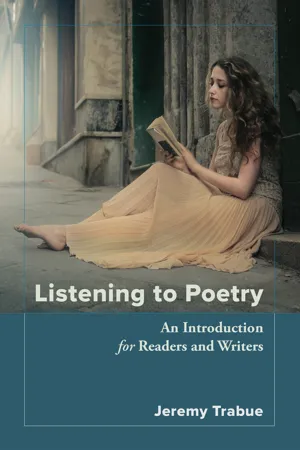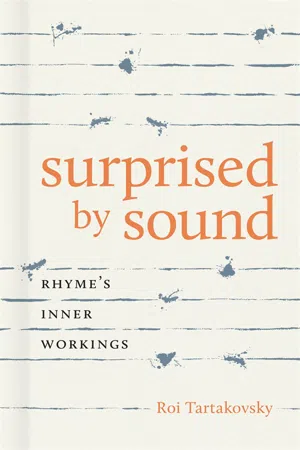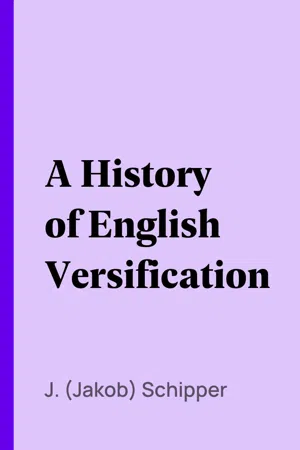Languages & Linguistics
Monorhyme
Monorhyme is a poetic form characterized by having all the lines in a poem end with the same rhyme. This creates a strong sense of unity and rhythm within the poem. Monorhyme is often used in Arabic and Persian poetry, as well as in modern English poetry, to create a sense of cohesion and emphasis on the repeated rhyme.
Written by Perlego with AI-assistance
Related key terms
5 Key excerpts on "Monorhyme"
- eBook - ePub
The Princeton Encyclopedia of Poetry and Poetics
Fourth Edition
- Stephen Cushman, Clare Cavanagh, Jahan Ramazani, Paul Rouzer, Stephen Cushman, Clare Cavanagh, Jahan Ramazani, Paul Rouzer, Stephen Cushman, Clare Cavanagh, Jahan Ramazani, Paul Rouzer(Authors)
- 2012(Publication Date)
- Princeton University Press(Publisher)
cywydd couplets, one of the rhymes must be a monosyllable but the other a polysyllable. But if rhyme depends for its distinctive effects on the morphology of the particular words involved in the rhyme, it also, therefore, depends on the morphological structure of the lang. itself as the ground against which the pattern becomes visible.Inflectional endings are, as it were, the antithesis or reflex of rhyme, though it is not accurate to say, as did Whitehall, that langs. in which like endings result automatically from inflection will never use rhyme as a structural device in verse. Rhyme is occasionally to be found, consciously used, in the lit. of the cl. langs. The notion of like endings (Gr. homoeoteleuton , Lat. similiter desinens ) is discussed by the ancients—Aristotle (Rhetoric 3.9.9–11), Dionysius of Halicarnassus (23), and Quintilian (9.3.77)—under the rubric of “verbal resemblance” or sound correspondence between clauses (paromoeosis ). Late antique *rhyme-prose continues this trad.; the *grammatical rhyme of the Grands Rhétoriqu eurs (see RHÉTORIQUEURS, GRANDS ) takes a different slant. But the two systems—case endings and rhyme—overwrite the same space and so in the main are mutually exclusive. And when, in any lang., rhyming is relatively easy, poets will tend to complicate it by employing forms of *rich or *identical rhyme (as in Fr.) or complex stanza forms (as in Occitan and Fr.) or both, or else by eschewing rhyme completely (as in *blank verse). Poets who choose to rhyme, in fact, walk a tightrope between ease and difficulty: too easy rhyming or too difficult rhyming eventually produce the same result—the poetic disuse of rhyme. In some verse systems, the rules in a prosody survive sometimes for centuries after the ling. facts on which they were originally based have disappeared. One of the chief instances of this process is the mute e - eBook - ePub
Listening to Poetry
An Introduction for Readers and Writers
- Jeremy Trabue(Author)
- 2019(Publication Date)
- Chemeketa Press(Publisher)
At the other extreme, there are also many people who think of nonrhyming poetry as “modern” and rhyming poetry as “traditional.” This is also inaccurate. Old English poetry did not rhyme at all, nor did much poetry in Middle English. Unrhymed verse has been part of modern English right from the beginning. Seventeenth-century poet John Milton wrote a blistering attack on rhyme in his introduction to Paradise Lost (which does not rhyme). And most early English dramatic verse is mostly written without any rhyme (though some short rhyming passages do appear in Shakespeare and other renaissance drama).The role and importance of rhyme in poetry was much debated and contested in Milton’s time, and it still is today. Unrhymed poetry is more common, but rhyming poetry is alive and well. Rhyme is not omnipotent or omnipresent. Rhyme does not define “poem.” However, it is a part of poetry, and it’s here to stay.Rhyme is one of those subjects for which the phrase “deceptively simple” was created. Most preschoolers recognize and can give examples of rhyming words. Most could easily recognize the rhymes in this list:bed / embed / said / read bay / weigh / astray / they wing / asking / unifying / testifying lady / bee / abbey / tabbyBut what exactly makes these words “rhyming”? The entire ending syllable is not exactly the same in each one because the ending syllables may start with different consonant sounds. The spelling is certainly not the same in each one. However, the ending syllable after its initial con sonant sound is the same. Notice that they don’t have to have the same number of syllables, either, as long as that final syllable sound after its initial consonant is identical.Rhyme is the repetition of the same vowel sound followed by the same consonant sound—if there is one—in the final syllable of two or more words and in close enough proximity that it creates an obvious pattern. That’s the basic definition, but there is a lot of variation just under the surface of that definition that you should be aware of.Varieties of Rhyme
Rhyme is such a rich subject that there are different varieties of rhyme.First, rhymes can be either internal or end. End rhyme occurs at the ends of lines, and is the most common.When people talk about rhyme, they usually mean end rhyme. Internal rhyme, - eBook - ePub
Surprised by Sound
Rhyme's Inner Workings
- Roi Tartakovsky(Author)
- 2021(Publication Date)
- LSU Press(Publisher)
1 Hearing and Listening to Rhyme If negotiating with linguistic constraints and literary conventions comes with the territory of writing poetry, rhyme occupies a great part of that territory. Certainly, in the case of English, it is difficult to overstate the association between rhyme and poetry, or the significance of rhyme to poetry. This association is attested to in rhetoric by rhyme’s synecdochic or metonymic substitution for poetry itself. Rhyme-as-poem is a prevalent trope throughout much English-language poetry and is nowhere more evident than in William Shakespeare’s ending of Sonnet 17: “You should live twice, in it and in my rhyme.” In practice, rhyme’s prevalence is attested to by the overwhelming number of rhymed poems written by generations of poets. Of course, rhyme is not the only sound device, nor the earliest in the history of English poetry. A perfect or full rhyme is, in fact, one of numerous poetic sound devices, including assonance, alliteration, consonance, and many forms of partial rhymes. But it is the more encompassing member among most of these weaker or partial sound relations because full rhyme typically requires a correspondence of both the vowel and the following consonant sounds of the last stressed syllable of each word. 1 Assonance was never used systematically in English verse, partial rhyme is best appreciated as a subset of full rhyme, and alliteration, while carrying its own historical connotations of Anglo-Saxon prosody, seems, at least in poetic consciousness, more distant and dimmed today than rhyme. 2 Rhyme, both historically and phonetically, is set up to stand out in the soundscape of the poem or of poetry. As prevalent as rhyme is (or was —a question I will get to momentarily), it is easy to forget that rhyme’s entry into English poetry was a gradual process and one that—in spite of scholarly interest—remains somewhat murky. Murkier yet is the larger question of the historical origin of rhyme itself - eBook - ePub
Reclaiming the Christian Intellectual Tradition
A Student's Guide
- Louis Markos, David S. Dockery, David S. Dockery(Authors)
- 2012(Publication Date)
- Crossway(Publisher)
Don Juan , the light operas of Gilbert and Sullivan, and comedy-driven Broadway musicals all make heavy use of feminine rhymes.) By truncating his trochaic lines, the poet ensures that his lines will end on a stress—thus allowing him to use masculine rhymes. Consider the difference in feel and gravity between the following two pairs of lines (truncated trochaic tetrameter, followed by trochaic tetrameter):Nothing in my hand I bring, / Simply to the cross I cling Nothing in my hand I’m bringing / Simply to the cross I’m clingingThere is a firmness and nobility in the first pair of lines that is compromised in the second by the use of the less stately feminine rhyme, “bringing/clinging.”CATEGORIZING STANZAS
Thus far, I have considered individual lines of poetry in isolation. When we read actual poems, we encounter them not as individual lines but as members of a tightly knit group of lines known as a stanza . These stanzas are defined both by the meter of the lines that make them up and by the rhyme scheme that binds the lines together. Though it is possible to make use of a stanza that does not rhyme, in nearly all cases, the stanza will contain at least one pair of rhyming words. To designate the rhyme scheme of a stanza, we use the letters of the alphabet. If the four lines of a four-line stanza end with the words “may/sea/day/me,” then the rhyme scheme would be written thus: abab . If the last four words were “may/day/sea/me,” then the rhyme scheme would be aabb . If the last four words were “may/see/you/me,” then the rhyme scheme would be abcb . Although the majority of rhymes are exact rhymes (feel/steal), poets often use rhymes that are not exact (known as off rhymes or eye rhymes - eBook - ePub
- J. (Jakob) Schipper(Author)
- 2013(Publication Date)
- Perlego(Publisher)
This break is a characteristic mark of the typical Old English alliterative line, which is made up of two rhythmical sections. The structure of this verse was at one time obscured through the practice of printing each of these sections by itself as a short line; but Grimm’s example is now universally followed, and the two sections are printed as parts of one long line. [10] Before entering into a detailed consideration of the alliterative long line, it will be needful to make a few general remarks on rhyme and its different species. § 10. Modern metre is not only differentiated from metre of the classical languages by the principle of accent as opposed to quantity ; it has added a new metrical principle foreign to the ancient systems. This principle is Rhyme. Instances of what looks like rhyme are found in the classical poets from Homer onwards, but they are sporadic, and are probably due to accident. [11] Rhyme was not in use as an accessory to metre in Latin till the quantitative principle had given way to the accentual principle in the later hymns of the Church, and it has passed thence into all European systems of metre. In our poetry it serves a twofold purpose: it is used either simply as an ornament, or as a tie to connect single lines into the larger metrical unity of stanza or stave, by the recurrence of similar sounds at various intervals. In its widest sense rhyme is an agreement or consonance of sounds in syllables or words, and falls into several subdivisions, according to the extent and position of this agreement. As to its position, this consonance may occur in the beginning of a syllable or word, or in the middle, or in both middle and end at the same time. As to its extent, it may comprehend one or two or more syllables
Index pages curate the most relevant extracts from our library of academic textbooks. They’ve been created using an in-house natural language model (NLM), each adding context and meaning to key research topics.




